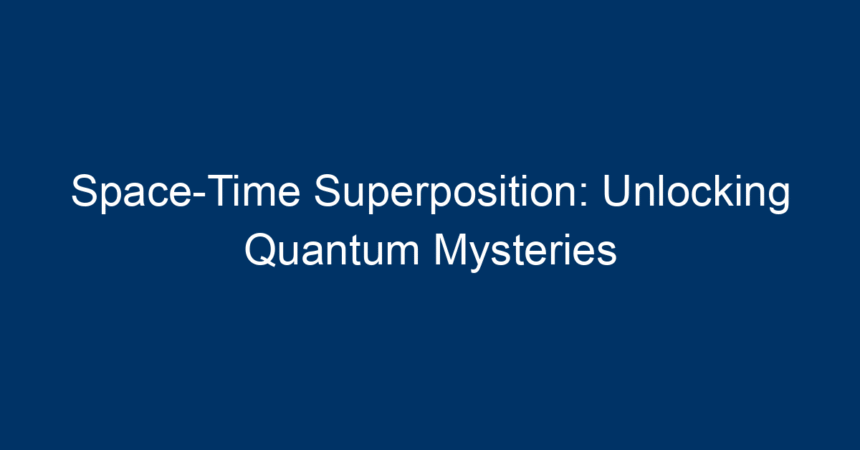Introduction
In the ever-evolving world of quantum physics, few phenomena captivate the imagination quite like space-time superposition. This concept not only challenges our understanding of the universe but also opens doors to potential technological advancements that could reshape our future. As we dive into the intricacies of space-time superposition, we will explore its fundamental principles, laying bare the mysteries of the quantum world while shedding light on its practical implications.
What is Space-Time Superposition?
At its core, space-time superposition refers to the idea that particles can exist in multiple states or locations simultaneously until observed. This paradoxical concept lies at the heart of quantum mechanics and is encapsulated in the famous thought experiment known as Schrödinger’s cat. In simple terms, until we observe a quantum system, it can exist in a superposition of all possible states.
The Quantum Realm: A Brief Overview
To understand space-time superposition, it’s essential to have a foundational grasp of quantum mechanics. Unlike classical physics, which describes a deterministic universe, quantum mechanics introduces a probabilistic framework. Here, particles do not have a definite position or momentum but instead exist in a cloud of probabilities.
This fundamental difference results in a range of phenomena, including entanglement, wave-particle duality, and notably, superposition. The implications of these principles extend beyond the theoretical realm, influencing various fields such as quantum computing, cryptography, and even the understanding of black holes.
The Mechanics of Superposition
Quantum States and Their Representation
In the quantum realm, a particle can exist in multiple states, represented mathematically as wave functions. Each possible state corresponds to a different quantum wave function, and the complete description of these states can be expressed as a linear combination of these individual wave functions. This is where superposition comes to life.
Mathematically, if a particle can be in state ( |A\rangle ) or ( |B\rangle ), it can simultaneously exist in a superposition state, denoted as:
[ |\psi\rangle = c_1 |A\rangle + c_2 |B\rangle ]
Here, ( c_1 ) and ( c_2 ) are complex coefficients that dictate the probabilities of finding the particle in either state upon measurement.
Observation Collapse: The Role of Measurement
One of the most intriguing aspects of space-time superposition is the act of observation. When a measurement is made, the superposition collapses to a single state—often leading to the famous observer effect. This phenomenon implies that the mere act of observation influences the state of a quantum system, challenging our intuitive perceptions of reality.
Space-Time Superposition in Practice
Quantum Computing: The Future of Information
Space-time superposition is not just a theoretical construct; it has profound practical implications. Quantum computing is one such realm where this concept reigns supreme. Unlike classical computers that process information in bits (0s and 1s), quantum computers leverage quantum bits, or qubits, which can exist in multiple states simultaneously due to superposition.
This allows quantum computers to perform complex calculations at speeds unattainable by classical computers. Problems in fields ranging from cryptography to drug discovery can potentially be solved more efficiently using quantum algorithms, revolutionizing industries and scientific research.
Quantum Cryptography: Enhancing Security
Another fascinating application of space-time superposition is in quantum cryptography. Underpinned by the principles of superposition and entanglement, quantum key distribution (QKD) allows for secure communication channels. With QKD, any attempt at eavesdropping can be detected, ensuring data integrity and security.
This technology illustrates how space-time superposition extends beyond theoretical implications, providing solutions to real-world challenges in cybersecurity.
Challenges and Mysteries
The Measurement Problem
While space-time superposition unveils tantalizing possibilities, it also raises challenging questions. The measurement problem remains one of the most unresolved issues in quantum mechanics. Why does the act of measuring a quantum system influence its state? What constitutes an observer? These are questions at the forefront of scientific inquiry, inspiring debates among physicists and philosophers alike.
The Quest for Quantum Gravity
Space-time superposition also intersects intriguingly with the quest for a theory of quantum gravity. As physicists attempt to unify quantum mechanics with general relativity, exploring how superposition traverses the fabric of space and time becomes increasingly vital. The concept might just play a crucial role in deciphering the mysteries of black holes and the origins of the universe.
Actionable Insights
-
Stay Informed: As research in quantum mechanics continues to progress, staying connected with reliable sources will help you keep abreast of new developments in space-time superposition and its applications.
-
Explore Quantum Technologies: Investigate how agencies worldwide are integrating quantum computing and cryptography into modern technology. Look for online courses, workshops, or webinars that delve into these fascinating areas.
-
Engagement in Discussions: Join forums, social media groups, or local meet-ups that focus on quantum physics. Engaging with others in discussions about concepts like space-time superposition can deepen your understanding and inspire fresh ideas.
-
Simplify Concepts for Others: Teaching others about space-time superposition can solidify your knowledge. Create blog posts or videos explaining this phenomenon in accessible language.
- Participate in Academic Research: For those deeply interested in physics, consider pursuing academic research opportunities. Many universities are exploring quantum mechanics, and participating can give you a front-row seat to cutting-edge discoveries.
Conclusion
Space-time superposition is more than just a curious aspect of quantum physics; it is a key that unlocks a world of mysteries and possibilities. As we continue to explore the implications of this phenomenon, the realms of quantum computing and cryptography will expand, ushering in a new era of technology and understanding.
By delving into the principles of space-time superposition, we not only grasp the intricacies of the quantum realm but also equip ourselves with insights that can shape our future. In a world where the boundaries of reality are continually pushed, understanding space-time superposition may well be the dawn of a scientific renaissance.




